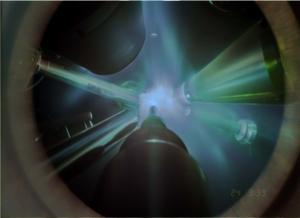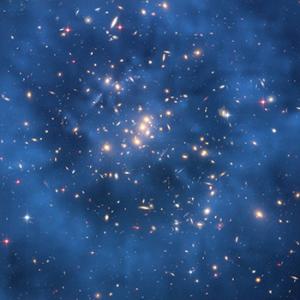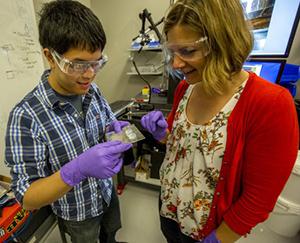LAB REPORT
Science and Technology Making Headlines
April 20, 2018


High-power lasers at the National Ignition Facility are focused onto a multi-stepped iron sample at the center of the 10-meter-diameter target chamber. These experiments measure the equation of state of iron under core conditions of large rocky exoplanets.
Lasers put the squeeze on iron
Physicists have simulated the cores of some large rocky exoplanets by pummeling iron with lasers. The resulting measurements give the first clue to how iron might behave inside planets outside the solar system that are several times the mass of Earth, researchers report.
“Until now, there’s been no data available on the state of these materials at the center of large exoplanets,” said Ray Smith, a physicist at Lawrence Livermore National Laboratory.
Working at the National Ignition Facility, Smith and his colleagues aimed 176 lasers at a pellet of iron a few micrometers thick wrapped in a gold cylinder. The lasers delivered enough energy over 30 billionths of a second to compress the iron to pressures up to 14 million times Earth’s atmospheric pressure at sea level. The researchers measured how the iron’s density changed at different pressures.
These high pressures are thought to be found in the iron cores of rocky exoplanets that are between three and four times Earth’s mass. Although our solar system doesn’t have any planets of this size, they are the most common type of exoplanet in the galaxy.


Forensic officers examine the site in Salisbury, U.K., where a former Russian spy was poisoned in March. Credit: Christopher Furlong/Getty
Beefing up chemical forensics
As investigations continue into the attempted assassination of a former Russian double agent and his daughter in Britain, findings released this week have renewed focus on the class of nerve agents allegedly used. And experts say that the United Kingdom event and a recent suspected chemical-weapons attack in Syria provide fresh impetus for international efforts to beef up forensic capabilities.
Forensic methods can build up chemical signatures of the components of a sample to give investigators leads about how it was made, said Brad Hart, director of the Lawrence Livermore National Laboratory’s Forensic Science Center. The varying ratios of stable isotopes of component elements, for example, can provide information about where the starting materials came from, he said.
Other sample components can offer clues about the methods of synthesis, potential starting materials and the sophistication of manufacture, he added. “Anything detected in the sample that is not the primary product is of interest as a potential signature,” Hart said. “These typically include unreacted starting materials, products of side reactions, breakdown or decomposition products of the primary product or other signatures.”


Extent of Arctic sea ice in September 2016 versus the 1981-2010 average minimum extent (gold line). Through satellite images, researchers have observed a steep decline in the average extent of Arctic sea ice for every month of the year. Image courtesy of NASA.
California could be left high and dry
A recent study shows that as climate warms and sea ice in the Arctic melts, the climate of California could become drier.
LLNL scientist Ivana Cvijanovic ran a climate model that melted most of the sea ice in the Arctic, which is projected over the next few decades. The melting of the ice leads to warmer ocean temperatures, which can lead to a change in atmospheric pressure patterns.
In the model, this parked a high-pressure system over the Pacific. With a high-pressure system in this location, it leads to the upper-level jet to be pushed to the north. This pushes storm systems and rain north through Canada as opposed to California, which could lead to more drought across the state.


Lawrence Livermore scientists and collaborators have a new tool to detect dark matter that may lead to a better understanding of the universe.
Listening in
A new device 40 years in the making could give new hope in detecting dark matter and a better understanding of the universe.
Four decades ago, researchers proposed a new low-mass particle (the axion) that could be critical in answering questions about dark matter. Lawrence Livermore researchers and collaborators might have a new tool in finding those particles.
The research came as part of the Axion Dark Matter Experiment (ADMX). The scienitss reported that they have finally reached the sensitivity needed to "hear" the signs of dark matter axions. The breakthrough happened after 30 years, and it positions the ADMX system to listen for axions more closely than any other project. A new quantum-enabled device adds to the ADMX system and gives it the "missing piece" it needed.
“The initial versions of this experiment, with transistor-based amplifiers, would have taken hundreds of years to scan the most likely range of axion masses. With the new superconducting detectors, we can search the same range on timescales of only a few years,” said Gianpaolo Carosi, co-spokesperson for ADMX and scientist at Lawrence Livermore.


LLNL chemical engineer and project lead Rebecca Dylla-Spears and LLNL materials engineer Du Nguyen have reported the synthesis of 3D printed transparent glass components using a “slurry” of silica particles extruded through a direct-ink writing process. Photo by Jason Laurea/LLNL.
Scientists see crystal clear
A new 3D-printing technique, developed at Lawrence Livermore, could allow scientists to print glass that incorporates different refractive indices in a single flat optic, making finishing cheaper and easier.
For the first time, the researchers have successfully 3D-printed optical-quality glasses, on par with commercial glass products available on the market.
The team successfully printed small test pieces from Lab-developed ink with properties "within range of commercial optical grade glasses." Depositing the LLNL-developed material in paste form and then heating the entire print to form the glass allows for a uniform refractive index, eliminating optical distortion that would degrade the optic's function.





